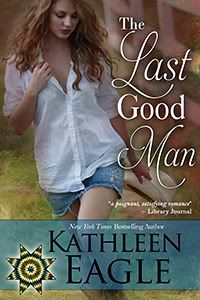GO WEST, DEAR READER
by Kathleen Eagle
As a military brat I’d lived in a lot of places by the time we moved toMassachusetts, but I was already in love with the West. I

felt personally insulted by my fifth grade teacher’s claim that, “It’s a vast wasteland west of the Mississippi River.” I later learned that the dyed-in-the-wool New Englander had never traveled west of theMississippi. She had no experience, presumably had never read a good book or seen a decent movie. I felt sorry for her.
The song “My Baby Loves the Western Movies” could have been written about me. I was born in Virginia, and I love the Tidewater area. I went to college in Massachusetts, and I love New England. But I never got over the allure of the West, and when the time came to seek my own adventure, that’s where I went. I’d lived in Idahoand Texas and traveled around many western states, but I’d never been to the Dakotas. One summer was all it took. I would finish school, prepare myself to set out on my own, and then I would test my mettle in a place where the natural world is the alpha and omega. The prairie has enormous power. It’s still God’s country.
What a romantic concept! I didn’t set out to write romance, but that’s the turn my fiction took when I finally decided to make stories from my limited experiences and boundless dreams. Most of my stories are set in the American West, and my characters are drawn against a backdrop of the kind of natural grandeur that gives a person pause. The sky rules. The overarching night sky is breathtaking. The morning and evening sky bookend the day in beauty, and an oncoming storm can be seen in all its power for miles. When I write, I’m temped to interpret or comment on images like these, but when I revise a scene, that kind of writing goes—or should go—out the window. I remind myself to show the landscape, let the reader see through the character’s eyes. The character who comes to the West will feeling something different from the one who’s lived there all his life. The reader get to do the interpreting.
THE LAST GOOD MAN is set in Wyoming. When it was time to spread her wings, Savannah Stephens decided her fictitious hometown of Sunbonnet was too small for her, and she flew off to New Yorkto realize the dream her mother had initiated for her. Now she’s back, her body wounded, her confidence gone, her roots damaged. The Western landscape allows her to hide while she licks her wounds. She can go underground like a prairie dog or a ferret. She can emerge without being seen and lose herself in sheer vastness. In order to convey Savannah’s experience, I have to know the details of the setting and use those details—the small town and the characters it creates, the height and breadth of the land and how that feels, the plants and animals, the scents and sounds, the very feel of the air.
The Western setting certainly lends itself to the independent, self-reliant, ever-patient caretaker that is Clay Keogh. He’s a rancher who works hard, a rugged fusion of visible strength and secret vulnerability, and he thrives on being needed. I’m telling you, he really is. But THE LAST GOOD MAN will show you.


9 Responses to “GO WEST, DEAR READER”